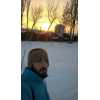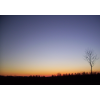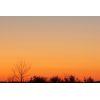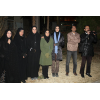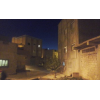Visibility of Jumadal Al-Aula Crescent 1438 AH
- When to Observe Jumadal Al-Aula Waxing (NEW) Crescent ?
- Jumadal Al-Aula Waxing (NEW) Crescent Observation Results
- The OFFICIAL First Day in Different Countries
- When to Observe Rabee' Al-Aakher Waning (OLD) Crescent ?
- Rabee' Al-Aakher Waning (OLD) Crescent Observation Results
When to Observe Jumadal Al-Aula Waxing (NEW) Crescent ?
The geocentric conjunction (Geocentric New Moon) will occur Inshalla on (Saturday 28 January 2017) at 00:07 UT.
Sighting the new crescent on (Saturday 28 January 2017) and (Sunday 29 January 2017) is shown in the below graphs using the program Accurate Times by Mohammad Odeh according to Odeh criterion. Where:-
- It is impossible to see the crescent from the areas located under the red color. Because either the Moon on this day sets before the Sunset and/or the topocentric conjunction occurs after the Sunset.
- The crescent is expected to be seen by optical aid only from the areas located under the blue color.
- The crescent is expected to be seen by optical aid from the areas located under the magenta color. In these areas the crescent could be seen by naked eye if the atmospheric conditions are superb and the observer is experienced.
- The crescent is expected to be easily visible by naked eye from the areas located under the green color.
- The crescent cannot be seen from uncolored areas, even though the Moon sets in these locations after the Sunset and the topocentric conjunction occurs before the Sunset, but the Moon is not sufficiently illuminated in order to be seen as crescent even by optical aid.
- Kindly notice that the below graph shows the possibility of seeing the crescent from areas between 60 degrees north of Equator down to 60 degrees south of Equator.


According to the Universal Hejric Calendar (UHC), which is based on the calculated crescent visibility, the start of this month in the Eastern Region will be on Sunday 29 January 2017 and in the Western Region will be on Sunday 29 January 2017. Kindly notice that the UHC is a pre-calculated calendar, which adopts a certain criterion to start the new Hejric month. Your country/organization might adopt different criterion to start the new Hejric month. So it is highly advised to read the UHC website before giving any judgment.
- Results of seeing the crescent, and the first day of the month in different countries will be added here Inshalla as we receive the reports from ICOP's members. If you wish to be a member in ICOP, or to know more about it, kindly click here.
Jumadal Al-Aula Waxing (NEW) Crescent Observation Results
Sat 28 January 2017
Iran
Mr. Hossein Janghorbani said: "Mr.Reza Janghorbani based in the city of Tabriz in East Azerbaijan province due to hazy weather, Not see the crescent moon."
Oman
Prof. Mohammed Al-Bussaidi said: "The weather condition was good and Crescent Moon was sighted by using a camera + telescope"
Saudi Arabia
Mr. Turki Alamri said: "AOD FOR 540 NM IS 0.07 I USED A 807 NM FILTER The crescent was difficult to catch, first image was 15 minutes after sunset . I tracked it for 5 minutes only due to some buildings in the western horizon."
United Kingdom
United States
Dr. Javad Torabinejad said: "I arrived at my sighting location (the Blacksburg Middle School) at 5:51 pm EST (sunset: 5:42 pm). The western horizon was clear and hazy. My first sighting was by looking through a pair of binoculars. It took me several minutes to see the crescent with naked eye, however. That was a difficult sighting; the crescent was thin with its horns at 4:00 and 7:00 O'clock (4:00;5:30;7:00). I stayed there till 6:32 pm when the moon was about to set (moonset: 6:37 pm)."
Sun 29 January 2017
Indonesia
Mr. AR Sugeng Riyadi said: "The new crescent of Jumadal Ula 1438 AH was not seen on Sunday, 29 Januari 2017 from my backyard at Bendo Ketitang Juwiring Klaten Central Java Indonesia. The sky was totally cloudy."
Iran
Mr. Hossein Janghorbani said: "In the name of God Jumadal Al-Aula Crescent Observation Report Astronomy and Geophysics Center of Shahreza – The Crescent Association of Shahreza Report by: Hossein Janghorbani (Najmosepehr-Sadrolmonajjemin) – Manager of Shahreza Crescent Association and Red Crescent’s Astronomy and Geophysics Center Date: Sunday, 01/29/2017 Location: Red Crescent Association of Shahreza (latitude: 32 00 N, longitude: 51 52 E, elevation: 1825m from sea level, time zone: +3.5 GMT) Equipments: One set of 15*70 binoculars,one compass. Atmospheric condition: Clouds and Hazy in western horizon. Horizon obstacles: about 2.5° Apparent sunset: --:-- Results: Crescent observed by Mohammad Javad Nikeghbal at 17:50 by naked eye. Other group members observed crescent by naked eye. Mr.Reza Janghorbani based in the city of Tabriz in East Azerbaijan province due to cloudy weather, Not see the crescent moon. Observers : 1. Mohammad Javad Nikeghbal 2. Ali Janghorbani 3. Hossein Janghorbani 4. Ziba Hafar 5.Masoomeh Hafar 6. Fatemeh Tavakoli 7. Mahsa Khajeh 8. Zahra Fallahi "
Morocco
Sri Lanka
Mr. Abdul Rahman Razeen said: "Aalaikum. Today 29-01-2017CE=29-04-1438AH is the sighting day for the month of Jumadal-oola 1438AH.. I was in Colombo and Went to Nimal road mosque Bambalapitiya 20 minutes before the Sunset.The horizon was cloudy. The parameters are(at Colombo) Sun set:6:19pm. Moon set:7:31pm. Lag=72minutes The prediction of the astronomers=Crescent can be sighted easily. I was associated by the students of higher grade from an arabic college called "Mawahibul-uloom". We couldn't sight it due to heavy shower but the CGM Hilal Committee had received positive sighting reports from eastern and northern province of Srilanka.. Hence it was decided by the CGMH Committee which was precided by Moulana Thasleem (Baari) along with ACJU and MRCA to complete the proceeding month as 29 days and start the month of Jumadal-oola on 30th of January 2017."
The OFFICIAL First Day in Different Countries
Sun 29 January 2017
1 . Indonesia
2 . United States
Mon 30 January 2017
1 . Iran
2 . Morocco
When to Observe Rabee' Al-Aakher Waning (OLD) Crescent ?
The geocentric conjunction (Geocentric New Moon) will occur Inshalla on (Saturday 28 January 2017) at 00:07 UT.
Sighting the OLD crescent on (Saturday 28 January 2017) and (Friday 27 January 2017) is shown in the below graphs using the program Accurate Times by Mohammad Odeh according to Odeh criterion. Where:-
- It is impossible to see the OLD crescent from the areas located under the red color. Because either the Moon on this day rises after the Sunrise and/or the topocentric conjunction occurs before the Sunrise.
- The crescent is expected to be seen by optical aid only from the areas located under the blue color.
- The crescent is expected to be seen by optical aid from the areas located under the magenta color. In these areas the crescent could be seen by naked eye if the atmospheric conditions are superb and the observer is experienced.
- The crescent is expected to be easily visible by naked eye from the areas located under the green color.
- The crescent cannot be seen from uncolored areas, even though the Moon rises in these locations before the Sunrise and the topocentric conjunction occurs after the Sunrise, but the Moon is not sufficiently illuminated in order to be seen as crescent even by optical aid.
- Kindly notice that the below graph shows the possibility of seeing the crescent from areas between 60 degrees north of Equator down to 60 degrees south of Equator.
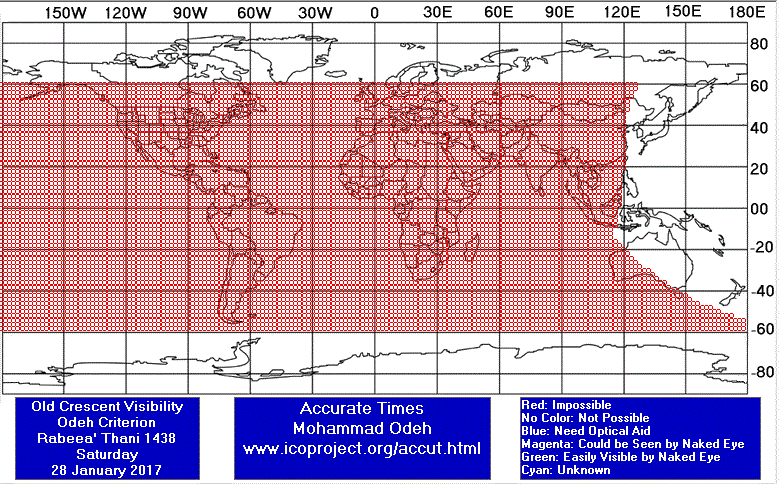
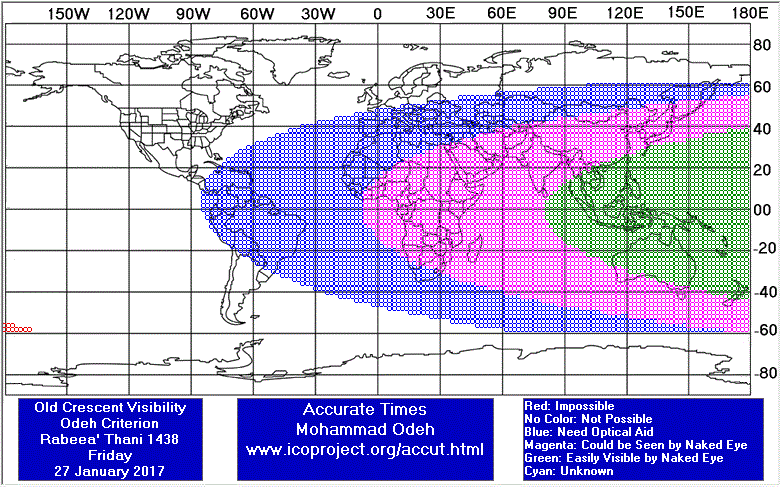
Rabee' Al-Aakher Waning (OLD) Crescent Observation Results
Fri 27 January 2017
Germany
Eng. Martin Elsaesser said: "The weather was fine but cold with snow on the ground. Due to a telescope mount malfunction i had troubles finding the not so difficult crescent. I swept back and forth with the imaging system till i found it. I then tracked it manually. I could not see it visually with the telescope but the imaging system showed it easily. The view was somewhat blurred due to high winds."
